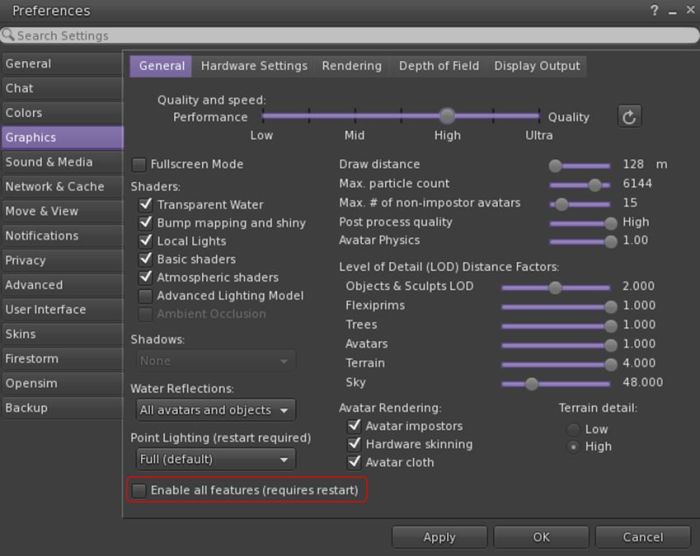 On July 18th, 2016, Strachan Ofarrel (Dave Rowe) released an updated Windows version of his CtrlAltStudio viewer. Version 1.2.6.43412 Alpha use Oculus Rift SDK 1.5.0 and so should support the Oculus CV1, DK2 and DK1.
On July 18th, 2016, Strachan Ofarrel (Dave Rowe) released an updated Windows version of his CtrlAltStudio viewer. Version 1.2.6.43412 Alpha use Oculus Rift SDK 1.5.0 and so should support the Oculus CV1, DK2 and DK1.
The release has been made to provide a level of Oculus HMD support in Second Life and OpenSim following the Lab’s decision to withdraw their own project viewer support for the Rift, after significant issues were found with the July update to that viewer.
However, as Strachan states in his blog post on the release, the CtrlAltStudio Windows update is presented “as is”, and still utilises the Firestorm 4.6.9 code-base, which is itself running well behind current releases, and therefore lacks functionality users might otherwise be familiar with in more recent versions of the SL viewer. This means CtrlAltStudio doesn’t support recent HTTP updates, inventory improvements or the TLS 1.2 update (so the built-in web browser will not work with things like Marketplace transactions when using the built-in browser).
Stratchan also warns that it is unlikely that users will get the level of recommended frame rates for CV1 use (which is something the Lab were stating prior to the release of their update), although he notes – again as did the Lab – that the experience should be enough to get a feel for what user-generated VWs are like in immersive VR.
Windows CtrlAltStudio users should be able to install this version over the 1.2.5 Alpha and 1.2.4 Alpha versions if they have either already installed. Those with older versions of the viewer should carry out a clean install (and can always back up and restore their settings before / after doing so). Note that if you install over the top of a previous version you may need to press the “Reset” button next to the “UI depth” Display Output option.

The full set of updates in this release are given as:
- Updated to Oculus Rift SDK 1.5.0 so that the viewer works with the Oculus runtimes supporting the CV1 as well as the DK2.
- Fixed the “UI depth” display setting to work for both DK2s and CV1s.
- Added an “FOV multiplier” display setting that decreases or increases the field of view with respect to the Rift-recommended value.
- Added a “Pixel density” display setting that decreases or increases the number of pixels rendered in the process of calculating the Rift display output.
- Removed the following display options which are no longer available in the Rift SDK: “Low persistence”, “Dynamic prediction”.
- Fixed crash at start-up if Rift display output is enabled but no Rift is connected and turned on.
- Updated the GPU table.
- Added an “Enable All GPU Features” display setting that enables all graphics settings that may otherwise be limited if a new, high performance GPU is not listed in the GPU table.
- Added a “Combine Xbox One triggers” joystick setting that combines the left and right trigger values of the Xbox One controller into a single value like the Xbox 360 controller outputs, thus letting the triggers be used to fly up and down.
It is worth noting that when in Riftlook mode, the cursor is only visible in the left eye. This is intended behaviour, allowing the cursor to hover over UI elements and in-world objects correctly without having to use additional and complex code to calculate what relative depth should be used to place the cursor in a stereo rendering.

Ai Austin has provided a blog post on his experiences in using this viewer, and I would recommend it for further reading, particularly in you are new to using the Rift with Second Life, as Ai provides point-by-point sets on getting started.
An interesting broader note in Ai’s post is with regards to using the HTC Vive with CtrlAltStudio – a questions which has been raised a a couple of “Meet the Lindens” sessions. In this regards, Ai:
Some users have reported that the CtrlAltViewer set to use the Oculus Rift works with the HTC Vive using LibreVR/Revive. This is a compatibility layer between the Oculus SDK and OpenVR. It allows you to play Oculus games on your HTC Vive.
Related Links
- CtrlAltStudio website
- Version 1.2.6.43412 Alpha release notes (including download link)
- CtrlAltStudio in this blog
- Testing CtrlAltStudio Viewer 1.2.6.43412 – Ai Austin
Great summary… its good to have VR back with OpenSim and Second Life thanks to David Row…
Please note you have a faulty link to my blog post… “Ai Austin has provided a blog post…” – it currently tries to open a “new post” on your own blog.
LikeLike
Thanks for the link notice.. corrected. There seems to be an issue with the WordPress.com update in link handling when using the “old” on-line editor. I normally catch these when they happen.
LikeLike
Hopefully these changes will also find their way to the Firestorm viewer.
LikeLike
Assuming the magic number is 60 fps to avoid the 6 minute ills … has anyone tested a CV-1 with Nvidia 1080 or SLI 1070’s high fps?
LikeLike